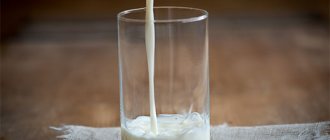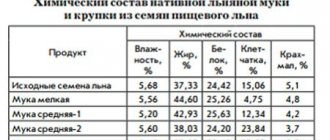Kefir, like other fermented milk products, has a beneficial effect on intestinal microflora. It contains approximately 20 varieties of beneficial microorganisms, including lactic acid streptococci, acidophilus bacilli, acetic acid bacteria and yeast. According to Russian GOST, their total quantity in 1 g of kefir must be at least 10 million units.
Such a rich composition of the popular drink explains its beneficial properties. When consumed regularly, kefir prevents the development of pathogenic flora in the intestines, strengthens the immune system, and improves metabolism. But only a high-quality and fresh product can bring benefits. In some cases it can be harmful and even dangerous:
- in case of violation of storage conditions;
- due to improper transportation;
- after the expiration date;
- if the packaging is damaged;
- due to initially low-quality raw materials.
Unscrupulous manufacturers add stabilizers, flavors, preservatives, and reconstituted milk to kefir. These components reduce the cost of the finished product, increase its shelf life, and improve its taste. They do not cause acute intoxication, but can provoke allergic reactions in young children and people with sensitive stomachs.
Sour kefir is even more dangerous. The fact is that fermented milk product provides a favorable environment for the growth of bacteria - not only beneficial, but also pathogenic. After the expiration date, the risk of kefir poisoning increases many times over.
But even a relatively fresh product can be dangerous if stored improperly. High air temperature, leaky packaging, and violation of sanitary standards during manufacturing act as a catalyst that accelerates the process of microbial proliferation. In this case, the beneficial flora dies, and putrefactive bacteria and fungi develop in its place. Once in the body with food, they cause poisoning.
Composition of real kefir
Remember: real kefir must consist exclusively of pasteurized milk and a starter of living bacteria - the use of vegetable fats in the production of this drink is strictly prohibited. Experts note that products with vegetable fat cannot even be called a kefir product - only a milk-containing product with a milk fat substitute. But the kefir product differs from kefir only in the type of starter.
Please note: the shelf life of natural kefir ranges from 1.5 (for a drink in a glass container) to 14 days. If it is a month or more, most likely the manufacturer replaced milk fat with vegetable fat.
Consequences of consuming expired kefir
Many people are interested in what will happen if they drink expired kefir. If the drink has been stored in the refrigerator for some time after its expiration date, then when consuming it, it is unlikely that any unpleasant symptoms will occur. But it is enough for kefir to stand at room temperature in an open state for only a few hours for pathogenic microorganisms to begin to actively develop in it. If you drink just a little of this fermented milk product, you will experience unpleasant symptoms such as bloating and severe rumbling in the stomach. This is especially common in people with a sensitive gastrointestinal tract.
When consuming a drink that has expired for more than a week (even if it tastes no different from good kefir), food poisoning occurs. It is characterized by the following symptoms:
- severe nausea;
- frequent vomiting that does not bring relief;
- constant diarrhea;
- increase in body temperature up to 38°C;
- weakness, general weakness.
A child drank expired kefir
If an adult still manages to cope with this condition, then the situation is much more serious when a small child drank expired yogurt or kefir. In this situation, there is no need to panic too much and self-medicate - you need to consult a pediatrician and be sure to monitor the baby’s condition. If necessary, the doctor will prescribe medications that remove toxic substances from the body and eliminate the symptoms of poisoning. If more than 2 hours have passed after drinking a fermented milk drink, and the child does not experience any unpleasant symptoms, it means that his body has successfully coped with pathogenic bacteria.
How to help with food poisoning
When consuming an expired fermented milk product, the body often experiences symptoms of gastrointestinal poisoning, which can be helped by some medications.
When food poisoning occurs, first of all, wash the stomach and artificially induce vomiting to cleanse the gastrointestinal tract of toxins.
After gastric lavage, you need to take adsorbents - Enterosgel, Polyphepan, Polysorb, activated carbon, etc. In addition, during this period you need to drink as much as possible so that toxic substances leave the body faster. One of the drinks that is beneficial for food poisoning is mineral water, which regulates the gastrointestinal tract and prevents dehydration.
If the patient's condition is serious, then self-medication is not allowed; consult a doctor immediately.
Taste and benefits
As for the taste and beneficial properties of kefir, they may change throughout the shelf life of the product. So, fresh, two-day kefir is less sour and also has a pronounced laxative effect. But a drink that is already three days old is more sour and has the opposite effect.
Experts say that natural kefir is rich in bifidobacteria and lactobacilli, as well as vitamins B and D. Well, if you want to choose the healthiest drink, pay attention to the freshest products with 2.5–3.2% fat content.
It is noted that the taste of high-quality kefir should not be too sour, bitter or sweet. But the color of a fermented milk drink depends on its fat content and the quality of the raw materials, and ideally it is white. And one more thing - never drink kefir with a strong smell!
Main symptoms of kefir poisoning
How many days does it take for kefir poisoning to appear? This depends on the metabolic rate, the state of the immune system and the number of microbes that have entered the body.
In young children, symptoms are noticeable almost immediately after drinking a poor-quality drink, in adults - after 2-3 hours. Malaise can be easily recognized by the following signs:
- nausea;
- vomiting;
- liquid, foamy, foul-smelling stool;
- flatulence;
- bloating;
- seething in the intestines;
- lack of appetite;
- pain in the navel area or below;
- weaknesses;
- fever;
- headache;
- heart rhythm disturbances;
- changes in blood pressure.
Severe poisoning with expired kefir is manifested by the following symptoms:
- convulsions;
- confusion;
- fainting;
- breathing disorder.
If you do not provide timely assistance to the victim, he will begin to become dehydrated due to diarrhea and vomiting. Children are more at risk than others: due to their low weight, even a slight loss of fluid can result in serious consequences. Dehydration causes disturbances in the functioning of the nervous and cardiovascular systems. If a child under one year of age is poisoned, call a doctor immediately.
Harm
Oddly enough, such a “harmless” food product can cause harm to the human body. This applies to those cases when he has been practicing mono-diet with only one kefir for a long time. After such a diet, the functioning of the immune system is disrupted and signs of vitamin deficiency appear.
The product is prohibited for use by persons suffering from an allergic reaction to milk and dairy products. Ingestion of even a small amount of protein can cause severe reactions, including the development of anaphylactic shock. You should not drink it if you have an increased tendency to dyspepsia and other functional disorders of the digestive system.
Patients with ulcers and high acidity of gastric juice need to remember that long-term consumption of a significant amount of sour milk leads to irritation of the mucous membrane. So-called low-fat kefir is also harmful for them.
What to cook from kefir: recipe for “Adyghe cheese”
Ingredients:
One liter of fat kefir;
Three liters of pasteurized or homemade milk;
Two tablespoons of fine table salt “Extra”.
Cooking method:
1. Place a container (small bowl) with kefir in a water bath and hold it without stirring, waiting for separation into cottage cheese and whey to begin. The curd will float to the top, and a slightly greenish liquid will remain below - whey.
2. When this happens, drain the contents of the bowl into a colander lined with gauze and wait until all the whey has drained. A liter of kefir yields approximately 250 grams of tender cottage cheese and the remainder in the form of whey.
3. Pour the whey into a jar and leave it warm, and you can eat the cottage cheese.
4. After two days, pour three liters of homemade milk into a large saucepan and bring to a boil. When the milk begins to boil, reduce the heat and pour the whey into it in a thin stream. Continue cooking over medium heat until the milk curdles. In this case, the cheese will rise to its surface in a continuous “crust”.
5. Turn off the stove, use a colander to remove the cheese from the pan and immediately transfer it to cheesecloth. Strain off any remaining whey by hanging the cheesecloth and cheese over the sink or wide bowl.
6. Form a head of cheese into the desired shape, place it under a press and put it in the refrigerator overnight.
7. In the morning, carefully unfold the gauze and you can take the sample.
Inpatient treatment and rehabilitation
If after all the actions taken the patient does not feel better, then he must be hospitalized. In a hospital setting, the actions of physicians should be as follows:
- The patient is given intravenous saline or glucose solution.
- Antibacterial therapy is prescribed depending on the results of bacterial culture.
- Forced diuresis is used (rare cases).
- Symptomatic therapy is carried out.
If a child is admitted to the hospital, he is given a drip with a water-salt solution to maintain fluid balance in the body.
After discharge from the hospital, the patient is prescribed a diet for several weeks. Moreover, on the first day, nutrition is limited only to liquid intake. Then the patient can eat light food: ripe bananas, baked apples, crackers, biscuits, porridge. Later, broths, vegetables, and boiled meat are added to the diet.
Read also: The benefits and harms of apricot kernels for the human body
What happens if you drink an expired product?
If a person accidentally drinks expired kefir, then there may be indigestion or nothing at all. Sometimes, after consuming expired food, the following unpleasant consequences occur:
- bloating;
- diarrhea;
- flatulence.
But such symptoms most often occur if the fermented milk product has been stored warm and open for a long time. If kefir is expired by only a few days, but was stored in the refrigerator, then its taste and color will be no different from the fresh product.
There are widespread rumors that the longer the kefir drink sits, the healthier it becomes. This is nothing more than speculation.
Where can I buy
You can buy starter culture for making kefir at home on our website and arrange delivery to any city in Russia. Residents of Moscow can use the convenient courier delivery service.
Courier delivery in Moscow
Available from Monday to Friday from 12 to 18 hours. Delivery cost - 300 rubles. When ordering over 1500 rubles, delivery is free. To calculate the cost of delivery, the price of the product before the discount is taken into account.
For residents of other Russian cities, goods are delivered by Russian Post
What can you do about the delay?
To prevent expired fermented milk products from harming your health, you can use them to prepare some dishes that undergo heat treatment. But for this purpose, it is permissible to use only kefir that is no more than a week expired, otherwise it is better to discard the fermented milk product. From a dairy product you can prepare:
- pancakes;
- vegetable and fruit pies;
- fried and baked pies;
- crumpets;
- cupcakes.
After baking or frying, dough with expired kefir drink does not pose a health hazard . Under the influence of high temperatures, all pathogenic microorganisms die.
Treatment of intoxication
The consequences of consuming expired sour milk are treated in the same way as food intoxication. First aid for a poisoned person is to lavage the stomach. Using this procedure, you can artificially induce vomiting, which will cleanse the gastrointestinal tract of toxins.
On the first day, it is not advisable for the patient to eat food: this increases nausea and causes vomiting. But mineral water will come in handy, as it regulates the functioning of the gastrointestinal tract and prevents dehydration.
From the next day you can gradually expand the menu. And, of course, avoid consuming expired fermented milk products.
Video: what can be made from expired kefir - recipes.
Banana smoothie with oatmeal recipe
Not only adults, but also children will enjoy this drink. This popular delicacy is not only tasty, but also very healthy. It will not be difficult to prepare, and the pleasure will be unforgettable!
You will need:
- banana – 2 pcs.;
- kefir – 600 ml;
- oatmeal – 4 tbsp. l.;
- honey or granulated sugar - 2 tbsp. l.
Cooking duration is 10 minutes.
Calorie content – 100 g/88 kcal.
Cooking steps:
- First of all, you need to arm yourself with a blender. Both an immersion bowl and a regular bowl are suitable for this;
- First of all, the dishes are filled with pieces of peeled ripe bananas (you can take slightly under-ripe or over-ripe ones, no big deal);
- Next, you need to pour in the required amount of oatmeal (you can use any available);
- At the final stage, you need to add honey or sugar and fill the entire contents of the bowl with kefir;
- Beat thoroughly until thick. All! Drink to your health!
Emergency help
A reasonable question, what to do, arises if you happen to be poisoned with kefir. Definitely, you need to call an ambulance, but you need to act before the doctors arrive.
Self help
Rinse the stomach with a solution of potassium permanganate
It is necessary to follow the standard algorithm of actions:
- Induce artificial vomiting. To do this, prepare a weak aqueous solution of potassium permanganate or table salt.
- Give a cleansing enema. To do this, you can use ordinary water or jelly water. It can be replaced with chamomile decoction (if you have it on hand).
- Drink any sorbent agent (activated carbon, polysorb, enterosgel, smecta).
- Drink in small portions (20 grams every 10-15 minutes). For drinking you can use still water, decoctions, compotes.
It is strictly not recommended to drink freshly squeezed concentrated juices or carbonated drinks.
There are still a few important points you need to know about.
You should not take medications whose action is aimed at stopping vomiting and diarrhea. You should not take antibiotics on your own, without the advice of a doctor.
Do not take antibiotics without a doctor's prescription
Treatment in hospital
The treatment protocol in the clinic is as follows:
- intravenous administration of glucose solution and saline;
- antibacterial therapy according to bacterial culture indications;
- forced diuresis;
- symptomatic therapy to improve the functioning of the cardiovascular system and central nervous system.
Rehabilitation therapy
Provided that the patient's physical condition is normal, a dietary diet is recommended . On the first day, it is recommended to refuse food and only drink plenty of fluids.
Gradually, baked apples, ripened bananas, biscuits, crackers and viscous porridges can be introduced into the diet. Then supplement the main diet with broths with chopped lean meat, vegetables and pasteurized low-fat dairy products.
To restore microflora, take probiotics.
Optimal conditions for maintaining freshness
Kefir is classified as a perishable product, and it is also extremely susceptible to incorrect storage conditions. In connection with these properties of the described fermented milk product, to maximize the period of its freshness, certain rules are followed.
The optimal temperature for maintaining the freshness of kefir is represented by the range -2…+3֯ C. Due to the fact that the average temperature value of the refrigeration compartment in a household unit is pleasantly +5֯ C, fermented milk products need to be stored on a shelf that is located as close as possible to the source of cooling.
Attention! Kefir, which contains specialized preservative compounds, can last in a cold place for up to 10 days.
When eating kefir, it is important to take into account that the fresh product (up to two days from the moment of preparation) has a laxative effect on the intestines, but after another 3-4 days, the effect becomes the opposite. Each subsequent day of storing such a food product in a refrigerator leads to the formation of a larger volume of acid and an increase in the percentage of ethyl alcohol. On the third day, the alcohol content in the fermented milk product can reach 0.88%.
Storing fermented milk drink in open containers
The shelf life of such products depends on the tightness of the packaging and other conditions in which it is kept. When the package is opened, from that moment on it is permissible to keep kefir exclusively for 24 hours. After the specified time period, the product begins to peroxidize and loses the vast majority of its beneficial properties.
It is possible to eat a fermented milk product whose packaging has been damaged within 36 hours from the moment of opening. This time is the longest period after which it is advisable to dispose of the remaining kefir or use it for culinary purposes. It is undesirable to use such kefir in its raw form, even as animal feed. Also, a drink that was left at room temperature (+18…+28֯ C) will become acidic after 4-6 hours. It is undesirable to open a fermented milk product when it is not planned to be used within the next 24 hours.
Storing fermented milk drink closed
In hermetically sealed original packaging, kefir can be consumed until the expiration date specified by the manufacturer has expired, provided that the standards for transportation and storage of the product are observed. However, the temperature values on home and store refrigerated shelves or in a specialized body do not always correspond to kefir storage standards. Instead of the established -2…+3֯ С, the product is stored at +5֯ С and above. Due to violations of temperature standards, the shelf life and storage of fermented milk drinks in the refrigerator is reduced.
Shelf life of different types of drink depending on packaging
The storage period for kefir in a hermetically sealed container, for example a bag, is written directly on the packaging. However, positive properties can only be maintained by a “live” fermented milk drink, the shelf life of which varies depending on the packaging in which the product is packaged. When the recommended temperature values are not observed in the refrigerator at home, the shelf life of such fermented milk is reduced significantly. In accordance with legally established rules, the shelf life of kefir is represented by the following values:
- in polymer packaging – up to 72 hours;
- in glass containers – up to 36 hours;
- in cardboard bags – up to 24 hours.
The manufacturer does not have the right to deviate from the above standards, which is confirmed by the fermented milk products sold and the expiration dates written on them. That is why the shelf life of, for example, baby kefir is 8 days, since it contains reconstituted milk, whose shelf life is longer than ordinary milk.
Attention! Kefir prepared with your own hands using a starter culture can maintain freshness for one to three days, depending on the storage temperature. The rules for preserving the freshness of homemade kefir and fermented milk products made at the factory are similar. But the shelf life of a drink made at home is shorter - it can be kept in a refrigerator for up to 5 days, and then this kefir gradually peroxidizes.
Shelf life of biokefir
This fermented milk product has gained high popularity in recent years; its main difference from ordinary kefir is that it is made with the addition of bifidobacteria. These microorganisms help normalize the functioning of the gastrointestinal tract, and also help restore its beneficial microflora after a course of treatment with antibiotic drugs and other potent medications.
The rules for storing biokefir largely depend on the degree of its maturity. So, the degree of maturity of the drink is calculated as follows:
- Weak effect – up to one day from the moment of packaging.
- Medium impact – up to 48 hours from the date of manufacture.
- Intense influence - up to three days from the moment of spilling into packages.
Such kefirs differ in their alcohol and carbon dioxide content, which increases as the fermented milk product matures. However, keeping the product in the refrigerator and subsequently eating it is permissible only for the period and under the conditions recommended by the specific manufacturer on the packaging. Each company has its own recipe and uses certain bifidobacteria, on the basis of which the freshness period of a particular fermented milk product is calculated.
Storing fermented milk drink at room temperature
When there is no way to put it on the cold shelf of the refrigerator, the processes of souring and fermentation occur inside the drink at an accelerated rate. Therefore, fermented milk products should not be kept at room temperature (+18…+28֯ C) for longer than 6 hours. In this case, an important condition is the protection of the described drink from contact with direct sunlight. Drinking kefir that has been outside the refrigerator for more than 6 hours is dangerous to your health. When a fermented milk drink has stood at room temperature for about 3 hours, when it is sent to the refrigerator, the shelf life is halved.
Storage period for curdled milk
Yogurt is a fermented milk product related to kefir, which also has its own, strictly defined shelf life. The time during which curdled milk is able to retain its original qualities when stored in a refrigerator on the coldest shelf is represented by three days. After the specified period, it is not recommended to use this version of fermented milk. Reference! Similar freshness periods are provided for homemade yogurt, while store-bought yogurt in original packaging with preserved integrity can be stored for up to 1.5 months (if the package is opened, then such a product is good for up to 12 hours) at a temperature of +2…+4֯ C.
Storing kefir frozen
Storing kefir in a low-temperature chamber is acceptable for 10-15 days. However, after defrosting, the fermented milk product loses its original structure, some taste characteristics and beneficial properties. In connection with such changes that have occurred with kefir, after thawing it is permissible to use it exclusively for the preparation of homemade cottage cheese, casseroles, cheesecakes and other culinary dishes that are subject to heat treatment, based on cottage cheese.
Storing kefir depending on the manufacturer and option
It is possible to extend the freshness of kefir by creating different conditions for this fermented milk product. The table shows a list of standard options for storing kefir, as well as the acceptable periods during which fermented milk retains its original qualities or is suitable exclusively for use for culinary purposes as part of other dishes.
The table shows the maximum permissible shelf life of kefir made by the most popular manufacturers.










